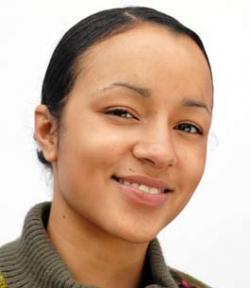
Contrary to popular opinion, the way mixed-race people look is not the primary influence that determines what part of their heritage they identify with, according to Seattle clinical psychologist and independent scholar Dr. Maria P. P. Root. She says a host of other factors comes into play.
“I consider the generation people were born into, the geographical region they came from, the community where they grew up, language, religion, parents’ identity, home values, and even the names they were given,” says Root, who is Filipino and white. “I also look at such things as individual traits. Someone who is very socially skilled and multitalented at a high level—a musician, an athlete, or a scholar, for example—has more identity options.
Race or gender often become secondary to the part of identity associated with the area of talent. It is almost as though people loosen the rules around race and bigotry if an individual has an exceptional skill that society values and gives the OK to look at a person more as an individual. All of these are very critical influences in how someone is going to identify.”
Root’s theory about why multiracial people tend to choose one part of their heritage over another began evolving in the 1980s when she discovered that the available literature on mixed-race people was dated. “With few exceptions, it was very pejorative,” she says. “A lot of it reflected the politics of the time, which was against race mixing, and it just did not match the experiences of the multiracial people who were writing doctoral dissertations.”
That gap led to Root publishing the award-winning book, Racially Mixed People in America, published in 1992. Many consider this highly acclaimed research-based book the definitive contemporary study on the subject, and the first major step in establishing Root as the premiere expert on mixed-race issues.
“Racial identity starts with family and community,” Root says. “People then begin to negotiate their identity for themselves once they go out on their own.”
By the time children are in school, peer influence plays a strong role, particularly when mixed-race children are half-black and half-white. “A child may feel comfortable socializing with black and white kids, but to be accepted by the black kids, she cannot go around saying ‘I’m multiracial,’” Root explains. “There is this sort of discrimination and testing of mixed-race people that is, unfortunately, the reenactment of an oppressive attitude around race.”
Such peer pressure and fear of rejection, often results in children identifying as black even though they are half-black and half-white. On the other hand, if they claim being multiracial, they may hide the fact that one parent is white. Some even choose not to identify with any race.
 “By the time multiracial people reach their early 20s, they usually know what they feel represents who they are and what they plan to say when people ask,” Root says. “They often become more comfortable as they come into contact with other mixed-race people and campus clubs for mixed-race college students, but for many people, getting comfortable with their identity is fraught with trauma. Until recently, the historical legacy of race relations deemed that if you were biracial, and part of that mix was white, you could not claim to be white. The U.S. Census Bureau reinforced this by telling you to assign yourself a race based on how the community saw you. You were supposed to know the rules. There are people who are now in their late 40s and older who feel, internally, that they are mixed-race, but who know they were never supposed to say as much. Outside, they say ‘I am African-American. I am Asian-American.’ They are complying with the so-called rules, but they still get tested.”
“By the time multiracial people reach their early 20s, they usually know what they feel represents who they are and what they plan to say when people ask,” Root says. “They often become more comfortable as they come into contact with other mixed-race people and campus clubs for mixed-race college students, but for many people, getting comfortable with their identity is fraught with trauma. Until recently, the historical legacy of race relations deemed that if you were biracial, and part of that mix was white, you could not claim to be white. The U.S. Census Bureau reinforced this by telling you to assign yourself a race based on how the community saw you. You were supposed to know the rules. There are people who are now in their late 40s and older who feel, internally, that they are mixed-race, but who know they were never supposed to say as much. Outside, they say ‘I am African-American. I am Asian-American.’ They are complying with the so-called rules, but they still get tested.”
Research by Root and other colleagues resulted in the 2000 Census changing from single-race categories to allowing participants to check all categories that apply. “That change accommodates the fact that the population as well as the socio-political sense of young people are changing,” she says. “There was a time when being multiracial meant a person stood out, but it is becoming the norm. It is also becoming normal for mixed-race kids with a particular racial combination to not identify the same way or use the same labels. Mixed-race people are trying to figure out the rules, but the rules are illogical.”
Unfortunately, the rules are just as confounding for everyone else. “It really perturbs people that mixed-race individuals have a tendency to change their identity,” Root continues. “You may meet someone who identifies a certain way. Then you meet them three years later, and they identify a different way. In addition, more commonly than not, multiracial siblings in the same family with the same biological parents identify differently than one another. It is all part of what some mixed-race people go through as they come into their own.”
“All of this makes you wonder what this whole race thing is about,” Root says. “As a nation, we are stunted in our ability to talk about race. Our cognitive development is supposed to evolve through the ability to mix two or three things simultaneously, starting with shapes and colors. We can look at the mix and its individual components in just about every area except race.”
Nevertheless, Root insists that we move forward in our efforts to talk. “Our public figures need to make room and time for in-depth talking,” she says. “But not just on a conceptual level. We need to converse on a feeling level: Why do you feel threatened enough to reject someone based on race? What were your most painful experiences when people misinterpreted what you were about? Such questions should cross all racial groups, including multiracial people. We must also address economic issues. Race has been intermingled with class, resulting in some groups being subjugated by poverty and becoming more invisible by class and color. In the meantime, the work done by a lot of us has helped younger mixed-race people feel more accepted and recognize that they have the right to exist and figure out who they are.”
Over the years, Root’s research has revealed some very telling commonalities among multiracial people.
Fifty Experiences of Racially Mixed People: By Dr. Maria P. P. Root
1. You have been told, “You have to choose; you can’t be both.”
2. Your ethnicity was mistakenly identified.
3. People assumed your race to be different by phone than in person.
4. You are accused of not acting or wanting to be Latino, Asian, black…
5. You have been told, “Mixed race people are so beautiful or handsome.”
6. Strangers looked between you and your parent(s) to figure out if you were related.
7. You have been told, “You don’t look Native American, black, Latino…”
8. You have been asked, “What are you?”
9. People say things they might not otherwise say if they knew how you identified racially.
10. You have been asked, “Where are you from?”
11. You have repeatedly been the recipient of stares or longer-than-passing glances from strangers.
12. You have been told, “You look exotic.”
13. Your choice of friends has been interpreted as your “selling out” or “not being authentic.”
14. You have been accused of “acting or wanting to be white.”
15. Judgments of your racial authenticity have been based upon your boyfriend’s or girlfriend’s (partner’s) race.
16. Comments are made about your hair or hairstyle, skin color, eye shape, etc.
17. You have been subjected to jokes about mixed-race people.
18. You have been told, “You think you’re too good for your own kind.”
19. Grandparent(s) or relatives do not accept you because of your parents’ interracial relationship.
20. Your parents or relatives compete to “claim” you for their own racial or ethnic group.
21. You have been told, “You have the best of both worlds.”
22. You have been asked about your racial or ethnic heritage as an object of curiosity.
23. Upon meeting you, people seem confused by your last name. They do not think it “matches” you.
24. People assume you are confused about your racial identity or have had a hard time figuring it out.
25. People speak to you in foreign languages because of how they interpret your physical appearance.
26. You have been told, “Society doesn’t recognize mixed race.”
27. You have been told, “You aren’t really black, Latino, Asian…”
28. You have been mistaken for another person of mixed heritage who does not resemble you.
29. You have been told you must be full of self-loathing or hatred because of how you racially identify yourself.
30. You have been told, “You are a mistake.”
31. Different people perceive your race differently based upon the company you keep.
32. The race people assign you varies in different parts of the U.S.A.
33. You have difficulty filling out forms asking for a single race.
34. You identify your race differently than others identify you.
35. You are told, “You aren’t like other Indians, Asians, Latinos…”
36. Your siblings identify their race differently than you do yours.
37. You have been called racial slurs of groups with which you do not share heritage.
38. Friends suggest that you date someone based upon the race or ethnicity with which they think you should identify.
39. Your parents identify your race differently than you identify.
40. You are told, “You aren’t black, Latino, Asian…enough.”
41. Your mother was assumed to be your nanny or babysitter.
42. A stranger assumes that your father is your “older boyfriend” or your mother is the “older woman.”
43. You were treated differently than a sibling by relatives or your parents based on racial features.
44. You were well liked by peers but were not asked for dates.
45. You wish you were darker and try to get as much sun as possible.
46. People assume your father was in the military.
47. You have enrolled in Spanish-language classes in order to develop the ability to say “Yes” to the question, “Do you speak the language?” and remove one of the blocks to authenticity.
48. Your otherwise friends become more distant when they think associating with you will make their racial authenticity or popularity questionable.
49. You have been knowingly approached and asked, “Your mother’s white (black, Asian), huh?”
50. You have tried to hide one or both parents from view of people who know you but are not your closest friends because you anticipate they will treat you differently.
